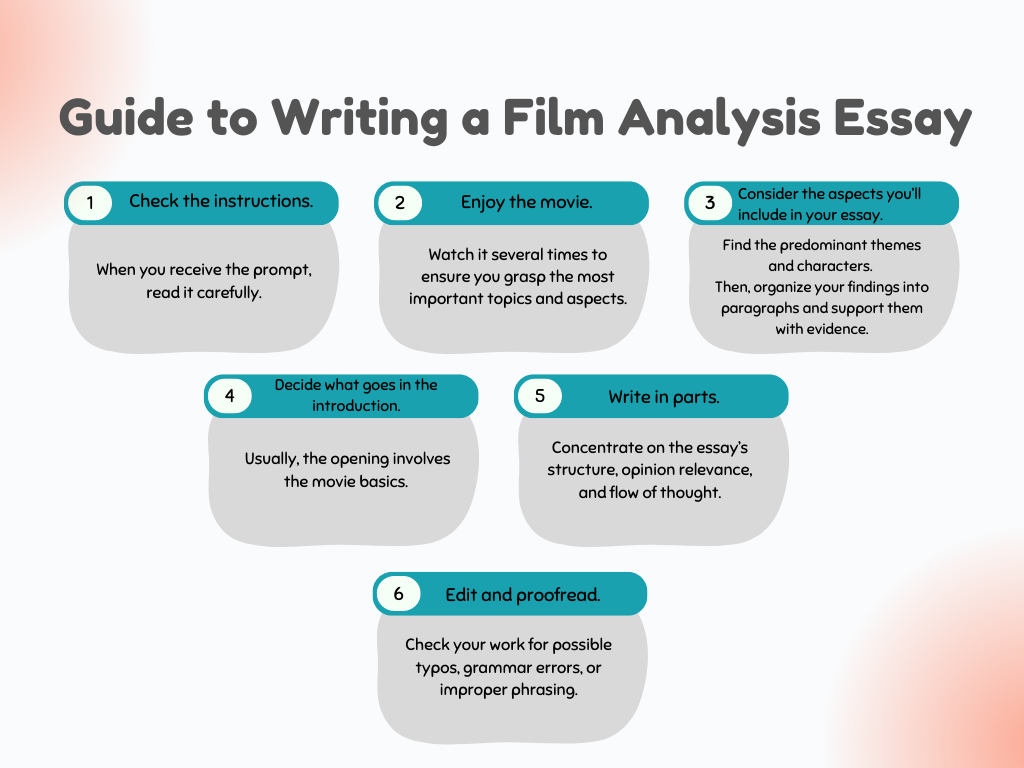Doesn’t a film analysis sound exciting? Who wouldn’t dive into their favorite movie of all time and present it in front of the whole class?
Undoubtedly, every youngster adores sharing impressions about the latest Netflix, Marvel, or Disney movies.
Yet, as thrilling as this thought might seem, it requires some hard work and fundamental knowledge about paper composition. A film analysis essay isn’t only a bare recounting of events and mentioning a few heroes and villains. Moreover, teachers often assign a specific genre, such as a documentary, a classic, or a musical.
In most cases, you’ll need to conceptualize a critical overview. Your work must elaborate on the storyline, actors, staging, music, and camerawork and prove your findings with appropriate evidence. As with any other analytical piece, this will consist of clearly divided and academically written paragraphs.
But how do you analyze a movie?
How do you draft an objective and informative piece that appeals to the broader masses? Don’t worry because we got your back. This blog post will help you write a film analysis essay from scratch to finish. Follow our advice to earn yourself some excellent grades.
What Is a Movie Analysis Essay?
By definition, a movie analysis revolves around the storyline of a film you or your teacher selected. It can be about any picture, but in most cases, you’ll have to write about features considered valuable for society. Their relevance can range from political and religious to artistic and intellectual.
Films worth analyzing carry sublime messages valid across several generations and aren’t for leisure only. They don’t just tell stories but teach priceless lessons and provoke powerful emotions.
The analysis should express your thoughts on the afterview synoptic. It will cover various aspects, including performance, cinematography, and screenplay writing. Though one film review might focus on one segment, like lighting, it’s best if it includes all elements to avoid being one-dimensional.
Moreover, the writing must be well-balanced and non-biased. It should provide detailed descriptions, references, and quotes from the actors. Another excellent approach is to link the dominant theme to topics in films produced by the same director and explain how they relate.
Different Film Analysis Types of Essays
As mentioned, you can pick a movie from almost any period or production and describe it. However, the complexity of some films allows writers to pick their reviewing perspective. Depending on your angle, you can choose between several film analysis options.
Narrative Analysis
These papers are similar to standard literary reviews. The essay will examine the scenes, the themes, the narrative structure, and the motives of each character. It aims to answer three questions related to the setup (where), heroes and villains (who), and problems and motifs (what). The more effort you put into describing the film’s techniques and the central themes, the better the outcome.
Semiotic Analysis
Motion pictures urge viewers to grasp more complex notions. Hence, semiotic analyses are about understanding the hidden meaning of the symbols presented on the big screen. Signs that carry a message will appear on many occasions, so your ability to pay attention to details is crucial. All great moving pictures have incredible symbolism that tells tales without using words.
Cultural Analysis
Also known as contextual analysis, this type reveals the cultural context of a movie. Unlike writing a summary of an article, a cultural analysis template deal with the inner world of the film. Hence, teachers consider it a more challenging task and assign it to culturally-aware learners. Above all, you must understand the social and political issues at the time and place of filming to write a compelling film analysis paper.
Mise-en-scène Analysis
This movie analysis elaborates on audiovisual elements, such as lighting, soundtracks, and background noises. Besides listing the key segments, you must also identify their importance. Though often irrelevant at first sight, audio and graphic elements have immense power to boost the plot.
Guide to Writing a Film Analysis Essay

The initial assignment may confuse an untrained eye with no clue where to begin. However, things will get easier once you get the main idea and draft the outline. Consider these tips to make the writing process as seamless as possible.
- Check the instructions. When you receive the prompt, read it carefully. Your arguments and the course in which you’ll steer your custom essay writing will depend on it.
- Enjoy the movie. Watch it several times to ensure you grasp the most important topics and aspects. Taking notes will help you keep track of the narration. Often, using a screenplay may further ease your attempts.
- Consider the aspects you’ll include in your essay. You can’t mention everything, so find the predominant themes and characters. Then, organize your findings into paragraphs and support them with evidence.
- Decide what goes in the introduction. Usually, the opening involves the movie basics. Summarizing all key concepts is also a must. The body will contain the analysis plus your views on whether the film reached its objectives. Finally, the closing will wrap up the movie and advice people to watch it or not.
- Write in parts. Work on the first draft that doesn’t have to be perfect. However, concentrate on the essay’s structure, opinion relevance, and flow of thought. They must all align with the preset requirements.
- Edit and proofread. No work will be complete without meticulous editing. Hence, check your work for possible typos, grammar errors, or improper phrasing.
Do you still wonder how to start a film analysis essay? Below is a detailed list of all the steps you should take when working on your manuscript.
Thesis Statement
Remember that this element is vital for the rest of your manuscript. The thesis should round up and squeeze the dominant narration threads. It explains what comes next and implies your thoughts on the elaborated topics.
This part should combine the film expectations, the author’s point of view, and your insight. As a final step, write a short and concise claim that makes a smooth transition to the introductory paragraph.
Introduction
The film analysis intro must be information-packed and catchy. It usually contains the film title, the director, the cast, the release year, and the cinema impact. It should also hook the reader and offer invaluable insights. Don’t forget to validate and highlight your claim.
If you still lack the skills to make an initial impact, consider a college application essay writing service to assist you at the onset. These experts will help you explore the relevant filmography and build links with current trends.
Body
Once you have the overall format, split the film into its constituents and bring each segment to the forefront. Here is a brief sample of what to mention:
- The script should have a logical sequence, whether it presents historical facts or depicts a love story. A well-written opening should spur the audience’s interest and contain amusing dialogue. When drafting, check the scene consistency and scripting clarity.
- Study the director’s style and patterns. Trace their distinctive methods and compare these to some previous works. If you buy a compare and contrast essay online, you will see what the ideal piece should cover.
- The way actors express their emotions has a massive effect on viewers. Their body language, dialect, and facial expressions are equally important. In most cases, an actor can make or break an otherwise excellent film. Your job is to show how their performance conveys the key messages.
- Sound and picture. Setting a positive mood is impossible without pleasant soundtracks and appealing visual effects. Give an example of how each segment (special features, makeup, sounds, and costumes) enables or interferes with expressing the author’s ideas.
Conclusion
Your ending must demonstrate that you can build logic between different segments. Therefore, ensure the resolution of the analyzed piece restates your claims and shows your viewpoints. The analysis must also appeal to the viewers and motivate them to check the film.
In general, most movies are complex art forms, so refrain from being shallow and touching the surface only. Be creative and try to offer a reply to controversial questions asked for centuries.



